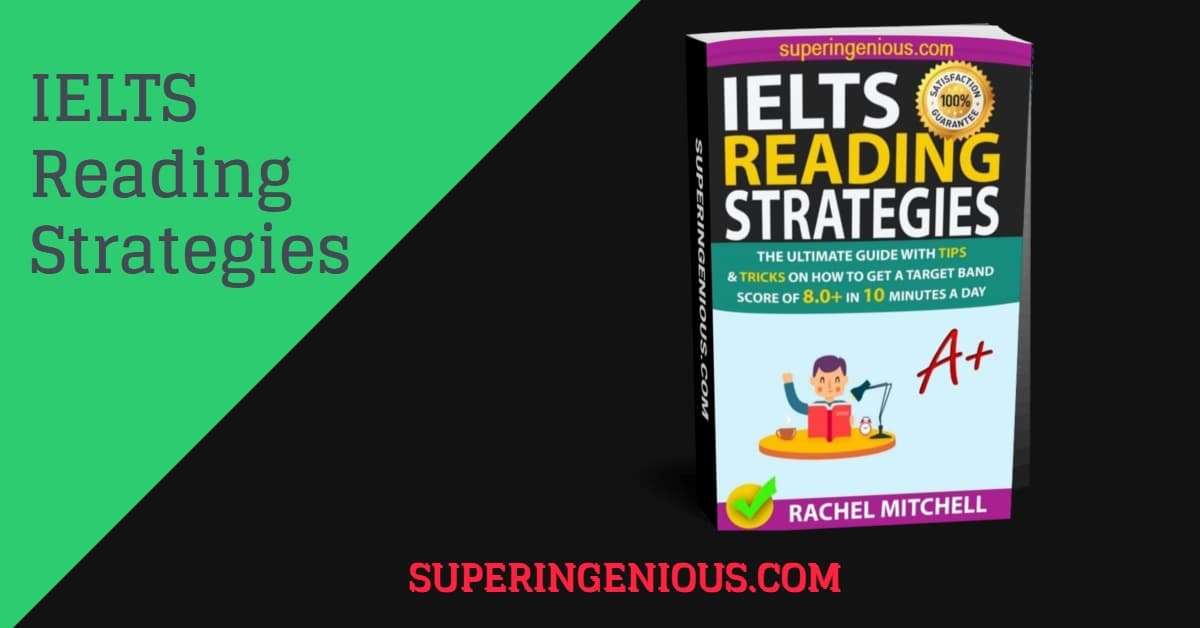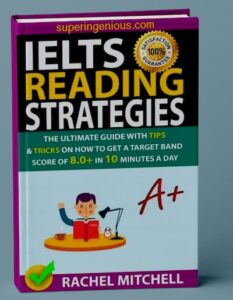IELTS Reading Strategies is an ultimate guide with tips and tricks for the IELTS reading test. The book will provide you with all proven Formulas, Tips, Tricks, Strategies, Explanations, Structures, Reading Language, and Synonyms to help you easily achieve your desired IELTS band score.

Advertisements
Strategies For IELTS Reading test
Here is a list of IELTS reading strategies:
- Because the time for the IELTS reading test is Limited, you don’t spend too much time reading the whole text. Do not read word for word everything you see. You don’t have to understand everything.
- Just go straight to read the questions first, and then read the passage.
- Use skills such as slamming and scanning to quickly read for the main idea or look for keywords or look for a specific detail like numbers, names, or dates. IELTS READING STRATEGIES.
- There are three passages in the IELTS test. The first passage is the easiest, then the second passage, and then the third passage. Since the first passage is easier, it’s a good idea to spend less time on this one.
- Don’t waste time on difficult questions, Do easier sections first, and do difficult sections later.
- Read all the instructions carefully. Especially for questions that require you to answer in NO MORE THAN THREE WORDS OR A NUMBER.
- Most of the answers to questions are in the correct order in the passage, so you don’t need to go back to the beginning to find the next answer.
- Search for and underline the “keywords”. Usually, some of the words in the questions have the same meaning to words in the passage. For example, if the passage includes the words “towns and cities”, ”elderly people”, the question might use the words “urban’: “senior citizens”. Therefore, you will probably find the answer if you find the similar words.
- Circling transitional words and phrases when you look for details such as “in contrast”, “however” in order to ensure that these words and phrases work as a sign that important information may appear before or after them.
- Predict the correct answer.
- Find the right part of the passage quickly. Read that part carefully. Read the sentences before and after the keywords that you have found to look for the correct answer.
- IELTS is very big on paraphrasing and using a range of different language for the same meaning. Therefore, when you look at questions or statements, you do need to think about possible paraphrases. That will help you identify where the answer is and to actually get the right answer.
- Common traps: one of the common traps you need to know is COMPARISONS. If you see a comparative sentence in the question “more or less than”, make sure you also find a comparison in the passage to find the correct answer.
- Also look for these types of words: if they say “all” and the question says “some”, that’s not a match. Likewise, if they say “the majority” and the question says “some”, that’s also not a match. This is really testing your ability to understand the exact difference and the exact meaning of words.
- Don’t “over-think” the answer. Many students get the wrong answer simply because they think too hard about small differences in meaning.
- Time management: you will have 60 minutes for the reading test with 40 questions in total. Therefore, you need to manage your time wisely.
- Transfer your answers from the question sheet to your answer sheet carefully. When you transfer your answers to the answer sheet, don’t get your answers mixed up spelling and grammar or you will lose points here. Don’t be in a hurry. Be careful to check and double-check. If your writing is unclear, your answer will be marked wrong.
Final Note:
I hope that you liked the book of today. Take action today and get the book from the links below. Study hard if you are willing to start over band 8.0 in IELTS Reading. I wish you all the best. Good Luck!


